Affiliate disclosure: This post may contain affiliate links. Please see our Privacy Policy.
Worcestershire sauce is one of those magical flavor-enhancing ingredients that I splash into just about everything savory. Something not quite right about a soup? Probably needs Worcestershire.
Chili a bit bland? Worcestershire sauce saves the day again.
As we work towards making more of our own foods, including condiments, from scratch I got to wondering…what’s in this stuff anyway?
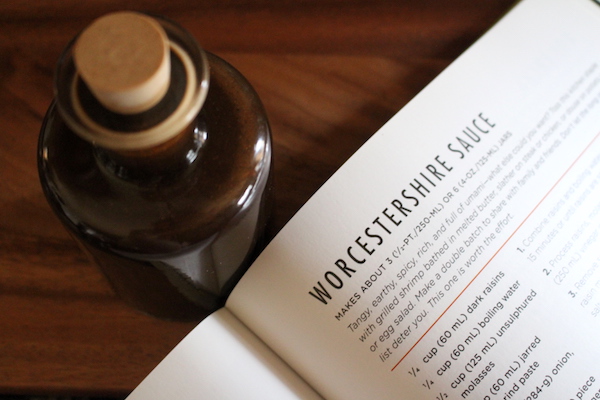
I’ll admit I was pretty intimidated by making my own Worcestershire sauce.
The old school traditional version is fermented in casks for over a year and contains a lot of fresh fish that slowly ferment during the process.
The original Worcestershire sauce recipe that was developed in England in the early 1800s is based on a fermented fish sauce that dates all the way back to the Roman Empire.
These days there are plenty of brands of Worcestershire sauce, and all of them have a slightly different flavor and consistency.
Worcestershire Sauce Ingredients
The two most commonly available versions, in the US at least, are Lee and Perrins and Annie’s Organics.
Since Lee and Perrins was founded in 1837 by the people that actually invented what is known today as Worcestershire sauce, their version is obviously the most “traditional.”
The Annie’s version has a much thicker consistency, and it’s vegan, so it lacks anchovies which are a key ingredient that provides most of the “umami” flavor that Worcestershire sauce is known for.
Either way, the Worcestershire Sauce ingredients lists for both commercial versions give you a good idea of how to make your own. Unfortunately, “natural flavorings” can be just about anything, but still, it’s a nudge in the right direction.
Lee and Perrins Worcestershire sauce Ingredients: Distilled white vinegar, anchovies, garlic, molasses, onions, salt, sugar, water, chili pepper extract, cloves, natural flavorings, tamarind extract
Annie’s Organics Ingredients (Vegan): Water, Apple Cider Vinegar, Molasses, Soy Sauce (Water, Soybean, Salt, Wheat, Alcohol), Cane Sugar, Tamarind, Sea Salt, Cornstarch, Xanthan Gum, Garlic, Onion, Clove, Chili Pepper.
Since I find the thick texture of Annie’s version pretty unappealing, I won’t be adding any corn starch or xantham gum. The thick dip-able texture is a better choice for a steak sauce like A1, but that more or less makes the vegan aspect pointless…
Choosing a Worcestershire Sauce Recipe
I started combing the internet for Worcestershire sauce recipes and I didn’t make it very far.
Just about all of them are a mixture of cider vinegar and soy sauce, with a few seasonings thrown in. None that I found contained anchovies, and all of them are ready to use as soon as you whisk them together.
Sure, instant gratification is nice, and it’s great for making a quick Worcestershire sauce substitute if you happen to run out…but it’s not what I’m going for. I’m trying to craft something special, and waiting for the flavors to come together just right is part of the process.
Disappointed, I shelved the project until I came across a recipe for Worcestershire sauce in The All New Ball Book of Canning and Preserving. The ingredients list is long, but reading through it, I happened to have all the ingredients waiting in my pantry.
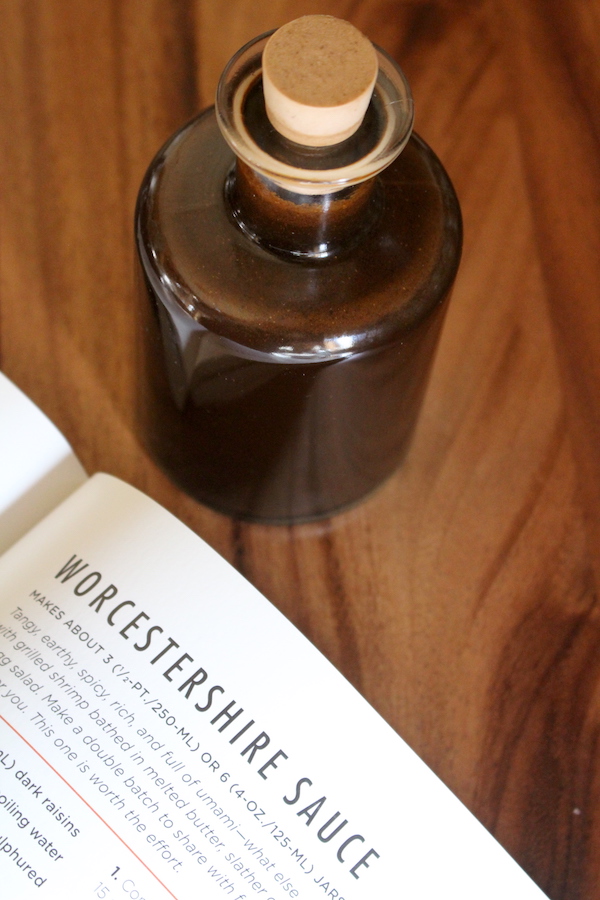
To be fair, I have a pretty well-equipped pantry, and most people probably don’t have tamarind paste or anchovies in stock at all times. Beyond those two things, the recipe is pretty basic pantry staples and spices.
The original recipe called for 1 tsp. anchovy paste and I’ve instead used a 2oz can of whole anchovies. A single teaspoon didn’t seem like nearly enough, especially since it’s the second ingredient in the Lee and Perrins Worcestershire sauce ingredient list.
I also substituted maple syrup for the brown sugar since we make our own homemade maple and have plenty on hand.
After a month of aging in the pantry, this homemade Worcestershire sauce is incredibly satisfying. It tastes surprisingly like the original, but with a little bit more warmth of flavor.
As an added bonus, I also have a jar full of Worcestershire sauce paste that was filtered out of the liquid sauce. It’s chunky, but has all the flavor of the original sauce.
The original recipe says to discard it, but that’s a shame. I’m saving it to add by the spoonful to soups. I imagine it could also be pureed finely and then dehydrated for use as a Worcestershire sauce powder.
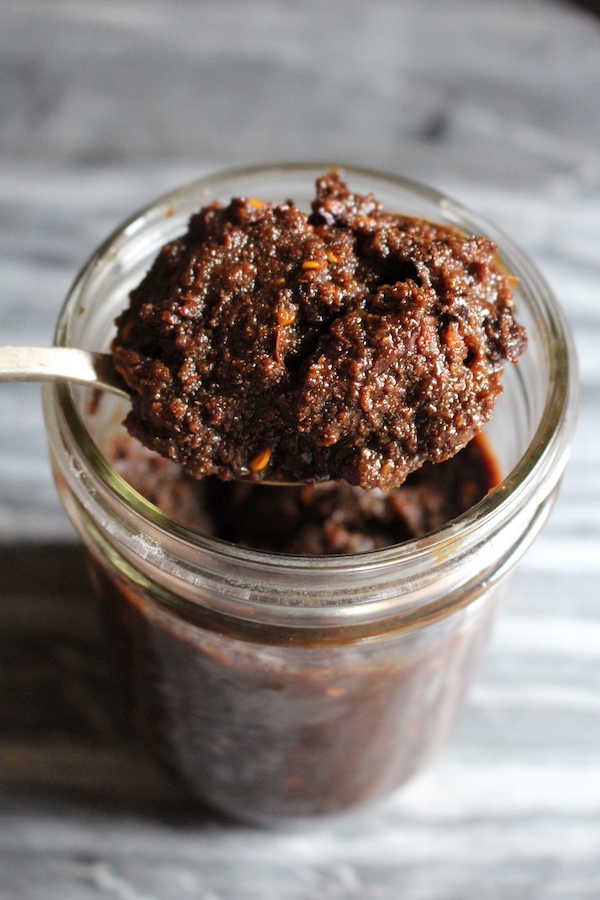
So all in all, is it worth the extra effort to make your own Worcestershire sauce?
It’s a fun project, and I’m amazed by how good it tastes. It’s less salty than the original, and the flavor is warmer.
I’m very happy with the results. I’ll make it again for sure.
This homemade version doesn’t exactly save money, and it’s not made with homemade ingredients either (unless you can grow both your own tamarind and anchovies…) but it is incredibly tasty.
Saving money and producing everything 100% yourself doesn’t have to be the only reason to try making something from scratch.
Sometimes it’s worth it just for fun kitchen science, with delicious results!

Homemade Condiments & Preserves
Looking for more easy homemade condiments and preserves?

Homemade Worcestershire Sauce
Ingredients
- 1/4 cup raisins
- 1/4 cup boiling water
- 1/2 cup un-sulfured molasses
- 1/4 cup tamarind paste
- 2- ounce can anchovies
- 1 onion, coarsely chopped
- 1- inch piece of fresh ginger, peeled & chopped
- 6-8 garlic cloves, crushed
- 2 cups white vinegar, divided
- 2 cardamom pods
- 2 Tbsp. kosher or canning salt
- 2 Tbsp. brown sugar or maple syrup
- 1 Tbsp. crushed red pepper flakes
- 1 Tbsp. dry mustard
- 1 tsp. whole cloves
- 1 tsp. black peppercorns
- 1/2 tsp ground cinnamon
Instructions
- Pour boiling water over raisins in a small bowl and allow to stand 15 minutes until raisins are softened. Drain and discard water.
- Place raisins, molasses, tamarind paste, anchovies, onion, ginger, garlic and half the vinegar (1 cup) into a food processor. Process until smooth.
- Pour the pureed mixture into a saucepan and add the remaining ingredients (including remaining vinegar). Bring the whole mixture to a boil, then remove from heat.
- Pour the mixture into a 1 quart canning jar, seal with a plastic lid and store in a cool, dark place for at least 1 month (or longer for stronger flavors).
- After aging, pour the sauce through a fine mesh sieve before use.
Home Preservation Projects
Looking for more from tasty home food preservation projects? Try any of these:
- How to make Pickled Eggs
- Dill Pickles Recipe for Canning
- Duck Breast Prosciutto (Salt Cured Duck Breast)
- Salt Cured Egg Yolks

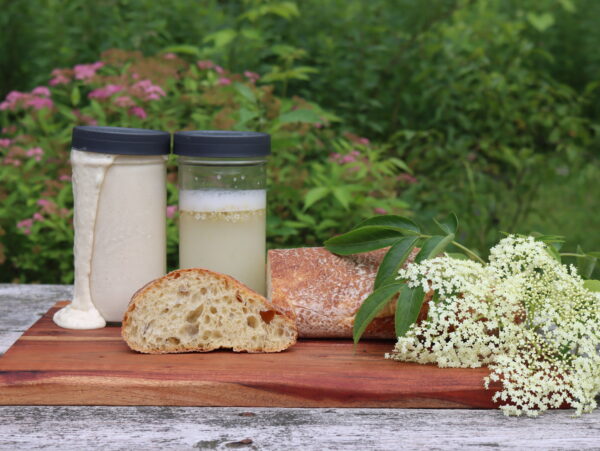
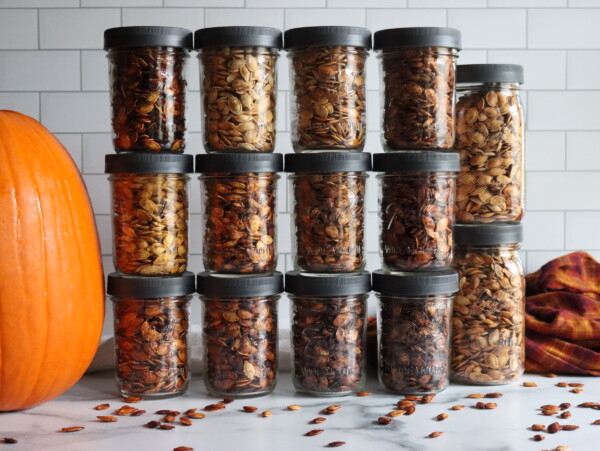


Ashley,
Can’t wait to try your recipe! Want to make some for family as well. Does this recipe double, and/or triple well? Also how much does the single recipe yield after its strained?
Thanks again for great recipes. I, too, just found your site and can’t wait to try some of your other recipes.
This recipe makes about 3 cups of sauce. I don’t see any reason why you couldn’t double it or triple it. If you give it a try, let us know how it works out.
Hi..i made this today..but mine was a bit more thick than yours…what should i do??add water or vinegar there??Please tell..
I would probably add more water and adjust the seasonings if it needs it.
Thank you!!😊
Ashley,
just found your site and love it so far. I’ve made my own Worcestershire before but I like the idea of using maple syrup. My next batch I am going to try it with some Sorghum syrup. When are you gonna join Instagram? would love to follow you there.
Thanks for your post!
Hi, Chris! I’m on Instagram: @ashley.adamant 🙂
Do you shake it while it is ageing?
I don’t, but it wouldn’t hurt if you do.
Hi Ashley,
Sounds like a good recipe – cant wait to try it out. Can we use old red wine instead of ACV?
I don’t see why not!
Should I use black or green cardamon pods as recipe doesn’t specify
We only have green here, so that’s what I used.
Where would these be located in the grocery store?
They would be with the spices.
Thank you,
As a like minded person I appreciate your insight. Happy trails from Western PA.
You’re welcome! ❤
I made this. It turned out wonderful. I use the sauce paste on steaks. I make my own A1 sauce and the addition of the paste puts it over the top! It has almost that same tangy smell quality as A1. So good! That most copycat A1 recipes lack.
Awesome. So glad you liked it!
I still want to make this vegan so thinking about using seaweed for the anchovies. I’m planning to use hijiki since it has a stronger and rich umami flavor. Any thoughts that might be useful?
Seaweed sounds like a great vegan substitution. Also maybe consider umami-rich dried mushrooms like shiitake. Enjoy!
I made some Worcestershire sauce last week using seaweed as my step son is vegan. Unfortunately, I had not seen this recipe at that point. IDK if seaweed is an exact substitute, but I was extremely happy with the results. I cannot wait to try this recipe! I actually have tamarind paste on hand! Admittedly, I’ve never purchased anchovies.
You will have to let us know how you like the recipe once you have had a chance to try it.
Can fish sauce be used in place of sardines? What would the volume used to substitute?
Fish sauce sounds like an excellent substitute for the anchovies, and may well result in better flavor since it’s been cultured to really bring out the umami in the fish. The amount…good question. If I were doing it, I’d try perhaps 1 tablespoon in place of the 2 ounces of fish. That’s a good starting point, but you may need to adjust from there.
Oof, just saw the other comment about mushrooms. No need to approve my previous comment since I have my answer. Thanks for sharing your recipe.
You’re very welcome!
I use Worcester sauce in my hambers. I once found black pepper soaked in Worcester sauce, I have soaked my own to replicated this. When I make this sauce I am definitely drying out the ‘toss out’ and adding black pepper and my other favorite spices♡
Easy writings nd language nd warmth.
What if we don’t want to use anchovies. I don’t eat from the Pacific ocean due to fish die offs and Fukushima radiation.
No worries, you can just skip that ingredient and still make a darn good sauce.
Anchovies are found in every ocean, most in Europe come from the Mediterranean and Atlantic. Check the country of origin. As a side note, coal fired power plants produce more radiation than nuclear power plants.
Radiation from coal fired plants? Explain.
No worries..anchovies don’t come from the Pacific Ocean!
Check the country of origin on the packaging. You may find that they come from European waters and don’t have that problem.
Your third from the last ingredient says 1 tsp of whole cloves. But whole cloves of what? Please respond.
Piotr O
Cloves are a common cooking spice here in the US. They’re often ground, but you can get them whole too. If using ground, which is more common, only use about 1/8 to 1/4 tsp because they’re strong. If you’re not familiar with cloves, here’s more info: https://en.wikipedia.org/wiki/Clove
I’m so glad I found you, I just love this recipe!!!
In the recipe you said, “Pour the mixture into a 1 quart canning jar, seal with a plastic lid…”
Is there a reason for the plastic lid versus the flat canning lids? Thank you.
I’ve discovered your blog a couple of months ago. We made the elderberry gummies, but instead of gummy bears we made hearts, jewels, and daisies. When major sickness passed through my girls’ school this past semester, they never caught the illness. Coincidence? Maybe. But it is a fun and tasty precaution either way.
Thank you for sharing your knowledge with us!
You can use regular canning lids for this, but I’ve found that things high in vinegar and salt really break down the canning lids if they’re opened and closed repeatedly. Eventually, the contents get a metallic taste and the rings rust. Given that this isn’t going to be canned, I use the BPA free plastic lids that ball canning sells. You can use metal though if you like if you haven’t had this issue.
That makes sense. Thanks you!
I had the same curiosity. Thanks for sharing your experience!
i really like your attitude! It’s true; sometimes making it at home from scratch isn’t really going to save any money, but it is preserving knowledge, which is probably more important in the long run. Thanks so much for the marvelous source of information.
once again , you rock girl ! where do you get all of these fantastic recipes ?
thank you again , Ron in Texas
How long will the Worcestershire sauce last and does it need to be refrigerated after strained?
It should last indefinitely since it’s basically a vinegar infusion. I keep mine in the pantry, and it’s still great several months later. The ball canning book says to put it in the refrigerator, and though I’ve found that unnecessary, that might be a good solution if you’re the cautious type.
I live in Australia where we have pretty warm temperatures. I think Worcestershire is generally kept in the fridge by a lot of people, but I am guessing the antimicrobial properties of the vinegar would stop it from being rancid.
Is there a non-fruit substitute for the raisins?
This is the traditional method for making Worcestershire sauce. You can probably just omit them but it will probably affect the flavor.
Wow! I will have to try this. I used to love Worcestershire sauce but developed allergies to soy. Your recipe is wonderful and I can’t wait to try it.
We hope you enjoy the recipe.
I strained the sauce this morning and cannot believe how tasty it is. My hubby used his finger to get every last drop out of the bowl. Thank you so much for this recipe! I will be using it again and again.
You’re welcome. So glad you enjoyed the recipe.
I have tried this before with prunes instead of raisins. It made fantastic hamburg (Japanese hamburger steak dish) sauce.
I am curious if you have a recommendation for a vinegar substitute? I have food allergies and that’s why I’m looking for DIY condiment recipes. White vinegar is in the corn category. Would lemon juice or apple cider vinegar work?
Apple cider vinegar is a good substitute, but I’d avoid lemon juice since it will really change the flavor. I do use apple cider vinegar in this because we make our own and have plenty on hand. That works wonderfully.
When you say seal us that tighten by hand ir a water bath seal
You just want to use a plastic lid and tighten it by hand.
mine has been in the fridge since I made it several months ago – Jan – Feb, ’21. It’s quite “thick” and I’m going to thin it with malt + ‘spirit’ [ordinary white] vinegar when I filter it in – Sept. [say Labour Day]. I used the recipe I found in “Glen and Friends” which is very similar to yours’, with all the basic ingredients – my thanks to you.